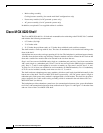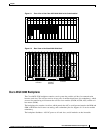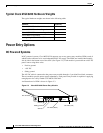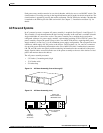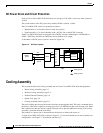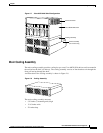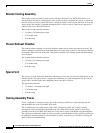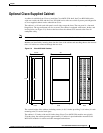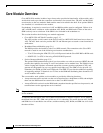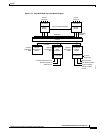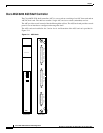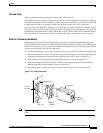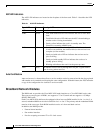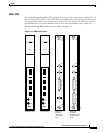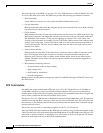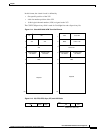
2-10
Cisco MGX 8220 Installation and Configuration
Release 5.0, Part Number 78-6430-03 Rev. D0, November 2003
Chapter
Core Module Overview
Core Module Overview
Cisco MGX 8220 modules include a larger front card to provide the functionality of the module, and a
smaller back card to provide the connectors and interfaces for external lines. The ASC and the BNM
are referred to as the core modules. Both modules must be installed in the shelf. If an optional SRM is
also installed, it is considered a core module.
If redundancy is required, a second set of ASC and BNM modules must be configured. Failure of an
ASC or BNM causes switchover to the redundant ASC, BNM, and SRM cards. Failure of the active
SRM card only causes switchover if the SRM is also included in the redundant set.
This section describes the following core module equipment:
• Cisco MGX 8220 ASC Shelf Controller, page 2-12
The ASC provides overall control of the shelf. Each Cisco MGX 8220 shelf must have at least one
ASC. The ASC back card also provides RS-232 and Ethernet ports to attach a control terminal or
workstation.
• Broadband Network Modules, page 2-14
The BNM provides the interface to the Cisco BPX network. The connection to the Cisco BPX
network is made in one of the following two interface combinations:
–
T3 or E3 line using the ATM STI, UNI, or NNI protocol and the Cisco BPX BNI or BXM cards.
–
SONET OC-3 or STS-3c line using ATM UNI/B-ICI protocol.
• Service Resource Modules, page 2-22
The optional SRM communicates with all service modules over a bit error rate test (BERT) bus and
provides the capability for testing T1 and E1 and subrate service module lines. The SRM can issue
various loopup and loopdown commands toward the customer premises equipment (CPE), and
generate test bit patterns for any user specified nx64-kbps port. The SRM can also provide 1:N
redundancy for FRSM, AUSM, and CESM cards. The SRM-3T3 provides the additional capability
of supporting multiple T1 channels over T3 lines on the SRM and distributing those channels to T1
service modules in the shelf.
The core modules work with the service modules to provide the following functions:
• Accept customer traffic received over the service interface lines, adapt them to ATM, and multiplex
them onto the BNM trunk for transmission to the Cisco BPX network.
• Accept ATM cells received over the BNM trunk, map them into the specified service protocols, and
transmit them over the appropriate service interface.
Note Chapter 4, “MGX 8220 Service Modules”, contains information on the functionality of the various
service modules.
A simplified block diagram of the Cisco MGX 8220 hardware is shown in Figure 2-10. As shown by
the dashed lines, the ASC, SRM, and cell bus are all 1:1 redundant. This means that one ASC, BNM,
and SRM slot set is attached to one cell bus, and the remaining ASC, BNM, and SRM slot set is tied to
the other cell bus.



